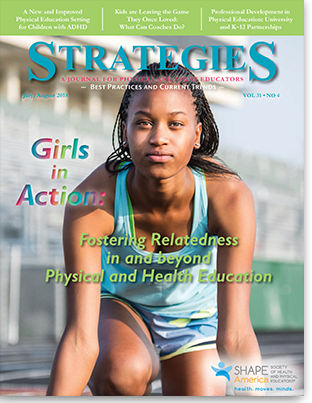 Strategies Table of Contents
Strategies Table of Contents
Girls in Action: Fostering Relatedness in and beyond Physical and Health Education
Jennifer Gruno, Sandra L. Gibbons, Richel Condie and Deanna Wilton

The aim of health and physical education (HPE) is to help children and youth develop physical activity and health behaviors that will benefit them
beyond HPE classes and throughout their lives. However, adolescent girls’ disengagement from high school HPE has been well documented (Camacho-Minano, LaVoi, & Barr-Anderson, 2011; Olafson, 2002). Girls are more likely than boys to report less positive attitudes toward HPE (Koca & Demirhan, 2004). Girls are also signifi cantly less likely than boys to enroll in HPE when it is no longer required, to attend HPE class daily when
it is required, or to participate in vigorous physical activity during the average HPE class (Centers for Disease Control and Prevention, 2004).
Additionally, educators struggle with the challenge of providing relevant HPE experiences for female students that extend beyond class. This disengagement has led to the examination of alternative curricula to facilitate girls’ engagement in and beyond HPE and the exploration of the type of learning environments preferred by girls. For example, making connections with community instructors and facilities to explore further physical activity opportunities in HPE has been identified as important for girls’ enjoyment, engagement and participation in HPE programs and physical activity outside of school (Gibbons, 2014; Pfaeffl i & Gibbons, 2010). Additionally, Gibbons (2009) found that girls placed considerable importance on the opportunity to actively choose and plan physical activities and on having a socially supportive learning environment.
This article describes a program, Girls in Action (GIA), designed by two high school HPE teachers in response to the need for providing relevant and meaningful physical and health activities to adolescent girls that extend beyond HPE class. Girls in Action is grounded in the concept of a relatedness supportive learning environment — an environment in which students have opportunities to develop healthy relationships with others. Relatedness is the feeling of being connected to others in a social context (Ryan & Deci, 2002). Relatedness is similar to the concept of connectedness, which describes a sense of belonging resulting from the bonds that students develop within a school (Libbey, 2004).
To read the rest of this article,
click here to download a pdf.